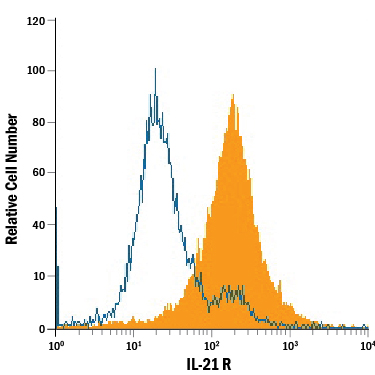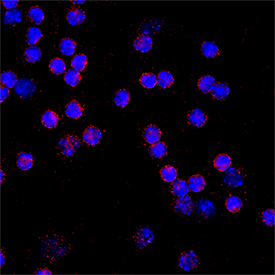Mouse IL-21R Antibody Summary
Applications
Please Note: Optimal dilutions should be determined by each laboratory for each application. General Protocols are available in the Technical Information section on our website.
Scientific Data
 View Larger
View Larger
Detection of IL‑21 R in A20 Mouse Cell Line by Flow Cytometry. A20 mouse B cell lymphoma cell line was stained with Goat Anti-Mouse IL-21 R Antigen Affinity-purified Polyclonal Antibody (Catalog # AF596, filled histogram) or isotype control antibody (Catalog # AB-108-C, open histogram), followed by Phycoerythrin-conjugated Anti-Goat IgG Secondary Antibody (Catalog # F0107).
 View Larger
View Larger
IL‑10 in Mouse Splenocytes. IL‑10 was detected in immersion fixed mouse splenocytes using Goat Anti-Mouse/Rat IL‑10 Antigen Affinity-purified Polyclonal Antibody (Catalog # AF519) at 15 µg/mL for 3 hours at room temperature. Cells were stained using the NorthernLights™ 557-conjugated Anti-Goat IgG Secondary Antibody (red; NL001) and counterstained with DAPI (blue). Specific staining was localized to cytoplasm. Staining was performed using our protocol for Fluorescent ICC Staining of Non-adherent Cells<.
Reconstitution Calculator
Preparation and Storage
Background: IL-21R
The interleukin-21 (IL-21) and its receptor appear to play important roles in the regulation of the immune system. IL-21 R, also called NILR (novel interleukin receptor) is a type I cytokine receptor with 4 conserved cysteine residues and an extracellular WSXWS motif. It is most closely related to IL-2 R beta and IL-4 R alpha. Mouse IL-21 R is a 529 amino acid (aa) residue protein with a 19 aa signal peptide, a 217 aa extracellular domain, an 18 aa transmembrane domain, and a 275 aa cytoplasmic domain. Mouse and human IL-21 R share 62% aa identity. IL-21 R is expressed on lymphoid tissues, peripheral B cells, and cell lines of T, B and natural killer lineage. Although not fully elucidated, the IL-2 R gamma ( gamma c) chain appears to play a role in IL-21 R signaling. The IL-21/IL-21 R interaction appears to play important roles in B and T cell proliferation after antigen stimulation and natural killer cell maturation.
- Parrish-Novak, J. et al. (2000) Nature 408:57.
- Ozaki, K. et al. (2000) Proc. Natl. Acad. Sci. USA 97:11439.
- Dumoutier, L. et al. (2000) Proc. Natl. Acad. Sci. USA 97:10144.
- Asao, H. et al. (2001) J. Immunol. 167:1.
Product Datasheets
Citation for Mouse IL-21R Antibody
R&D Systems personnel manually curate a database that contains references using R&D Systems products. The data collected includes not only links to publications in PubMed, but also provides information about sample types, species, and experimental conditions.
1 Citation: Showing 1 - 1
-
IL-11 Induces Encephalitogenic Th17 Cells in Multiple Sclerosis and Experimental Autoimmune Encephalomyelitis
Authors: X Zhang, N Kiapour, S Kapoor, T Khan, M Thamilaras, Y Tao, S Cohen, R Miller, RA Sobel, S Markovic-P
J. Immunol., 2019-07-24;0(0):.
Species: Mouse
Sample Types: Whole Cells
Applications: Flow Cytometry
FAQs
No product specific FAQs exist for this product, however you may
View all Antibody FAQsReviews for Mouse IL-21R Antibody
There are currently no reviews for this product. Be the first to review Mouse IL-21R Antibody and earn rewards!
Have you used Mouse IL-21R Antibody?
Submit a review and receive an Amazon gift card.
$25/€18/£15/$25CAN/¥75 Yuan/¥2500 Yen for a review with an image
$10/€7/£6/$10 CAD/¥70 Yuan/¥1110 Yen for a review without an image





